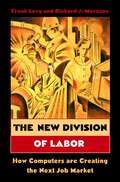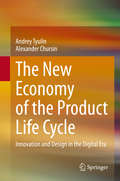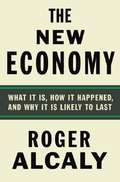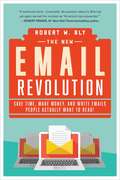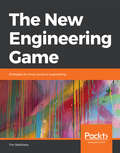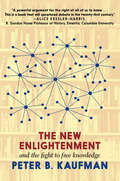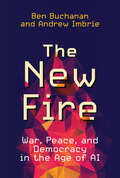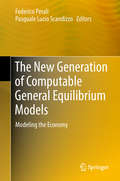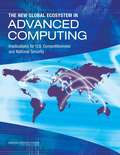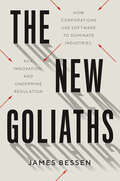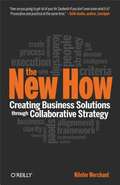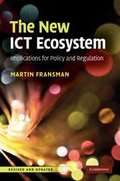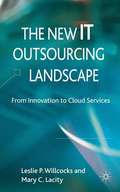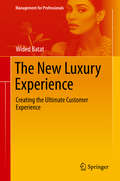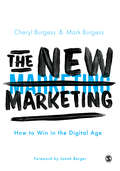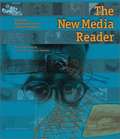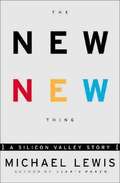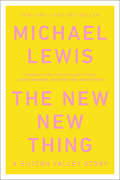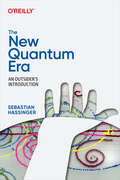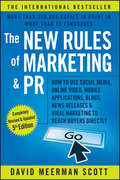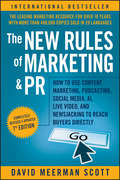- Table View
- List View
The New Division of Labor: How Computers Are Creating the Next Job Market
by Frank Levy Richard J. MurnaneAs the current recession ends, many workers will not be returning to the jobs they once held--those jobs are gone. In The New Division of Labor, Frank Levy and Richard Murnane show how computers are changing the employment landscape and how the right kinds of education can ease the transition to the new job market. The book tells stories of people at work--a high-end financial advisor, a customer service representative, a pair of successful chefs, a cardiologist, an automotive mechanic, the author Victor Hugo, floor traders in a London financial exchange. The authors merge these stories with insights from cognitive science, computer science, and economics to show how computers are enhancing productivity in many jobs even as they eliminate other jobs--both directly and by sending work offshore. At greatest risk are jobs that can be expressed in programmable rules--blue collar, clerical, and similar work that requires moderate skills and used to pay middle-class wages. The loss of these jobs leaves a growing division between those who can and cannot earn a good living in the computerized economy. Left unchecked, the division threatens the nation's democratic institutions. The nation's challenge is to recognize this division and to prepare the population for the high-wage/high-skilled jobs that are rapidly growing in number--jobs involving extensive problem solving and interpersonal communication. Using detailed examples--a second grade classroom, an IBM managerial training program, Cisco Networking Academies--the authors describe how these skills can be taught and how our adjustment to the computerized workplace can begin in earnest.
The New Economy of the Product Life Cycle: Innovation and Design in the Digital Era
by Alexander Chursin Andrey TyulinThis book presents the theory and practice of product lifecycle management, chiefly focusing on modern approaches suitable for digitalized enterprises. In addition to describing adaptive methods for advanced product creation using big data analytics, it presents economic and mathematical models for managing product lifecycles based on the application of recent methods (e.g. digital design and automated intelligent systems) to control pre-production and production processes. Given its scope, the book appeals to researchers, economic analysts and entrepreneurs alike.
The New Economy: What It Is, How It Happened, and Why It Is Likely to Last
by Roger AlcalyDefense of capitalism.
The New Email Revolution: Save Time, Make Money, and Write Emails People Actually Want to Read!
by Robert W. BlyPractices, strategies, and templates for optimizing your email use. The average business employee spends more than thirteen hours a week reading and responding to email. That’s 675 or more hours—over 28 days a year—spent on email. Wouldn’t it be nice to get some of that time back? In The New Email Revolution, Robert W. Bly Bly draws from decades of experience sending millions of emails to help you take that time back. With this book in hand, you will be able to quickly and easily: •Find templates you can use to create emails for dozens of different situations. •Know the right wording and optimal word length for email communication. •Get recipients to read and respond to your email messages. •Understand when it is legal and not legal to send email to a person you do not know. •Incorporate photos, graphics, sound, and video into your email messages. •Measure the deliverability, bounce rate, open rate, and response rate to every email you send. •Write clearer, more engaging, more persuasive email copy for every occasion. Get better results in less time with The New Email Revolution.
The New Engineering Game: Strategies for smart product engineering
by Tim WeilkiensAdapt to a world of digitalization and get ready to become a successful player in the new engineering game Key Features • Discover what the fourth industrial revolution is all about • Explore the new engineering game through the context of globalization, craftsmanship, and interdisciplinary engineering • Develop strategies to improve the engineering of products with functional architecture, lean systems engineering, and more Book Description Organizations today face an increasingly complex and dynamic environment, whatever their market. This change requires new systems that are built on the foundation of a new kind of engineering and thinking. The New Engineering Game closes the gap between high-level reflections about digitalization and daily engineering methods and tools. The book begins by describing the first three industrial revolutions and their consequences, and by predicting the fourth industrial revolution. Considering the fourth industrial revolution, it explains the need for a new kind of engineering. The later chapters of the book provide valuable principles, patterns, methods, and tools that engineering organizations can learn and use to succeed on the playfield of digitalization. By the end of the book, you'll have all the information you need to understand the various concepts to take your first steps towards the world of digitalization. What you will learn • Deal with the challenges of Conway's Law • Explore domains from different viewpoints with the Cynefin framework • Use the Business Model Canvas (BMC) to view your business model in one chart • Use the Business Model Navigator (BMN) to elaborate your business model • Get an overview of REThink 4.0 • Discover how to apply the principles of the Agile Manifesto for Software Development in your projects Who this book is for This book is for those of you who want to want to gear up for the ever-evolving and dynamic environment that has come into play with digitalization. Anyone who wants to create industry-grade applications using smart product engineering techniques will find this book useful. To grasp all that has been explained in this book, all you need is a knowledge-seeking attitude.
The New Enlightenment and the Fight to Free Knowledge
by Peter B. KaufmanHow do we create a universe of truthful and verifiable information, available to everyone?In The New Enlightenment and the Fight to Free Knowledge, MIT Open Learning&’s Peter B. Kaufman describes the powerful forces that have purposely crippled our efforts to share knowledge widely and freely.Popes and their inquisitors, emperors and their hangmen, commissars and their secret police—throughout history, all have sought to stanch the free flow of information. Kaufman writes of times when the Bible could not be translated—you&’d be burned for trying; when dictionaries and encyclopedias were forbidden; when literature and science and history books were trashed and pulped—sometimes along with their authors; and when efforts to develop public television and radio networks were quashed by private industry.In the 21st century, the enemies of free thought have taken on new and different guises—giant corporate behemoths, sprawling national security agencies, gutted regulatory commissions. Bereft of any real moral compass or sense of social responsibility, their work to surveil and control us are no less nefarious than their 16th- and 18th- and 20th- century predecessors. They are all part of what Kaufman calls the Monsterverse.The New Enlightenment and the Fight to Free Knowledge maps out the opportunities to mobilize for the fight ahead of us. With the Internet and other means of media production and distribution—video especially—at hand, knowledge institutions like universities, libraries, museums, and archives have a special responsibility now to counter misinformation, disinformation, and fake news—and especially efforts to control the free flow of information. A film and video producer and former book publisher, Kaufman begins to draft a new social contract for our networked video age. He draws his inspiration from those who fought tooth and nail against earlier incarnations of the Monsterverse—including William Tyndale in the 16th century; Denis Diderot in the 18th; untold numbers of Soviet and Central and East European dissidents in the 20th—many of whom paid the ultimate price. Their successors? Advocates of free knowledge like Aaron Swartz, of free software like Richard Stallman, of an enlightened public television and radio network like James Killian, of a freer Internet like Tim Berners-Lee, of fuller rights and freedoms like Edward Snowden. All have been striving to secure for us a better world, marked by the right balance between state, society, and private gain. The concluding section of the book, its largest piece, builds on their work, drawing up a progressive agenda for how today&’s free thinkers can band together now to fight and win. With everything shut and everyone going online, The New Enlightenment and the Fight to Free Knowledge is a rousing call to action that expands the definition of what it means to be a citizen in the 21st century.
The New Fire: War, Peace, and Democracy in the Age of AI
by Ben Buchanan Andrew ImbrieAI is revolutionizing the world. Here&’s how democracies can come out on top.Artificial intelligence is revolutionizing the modern world. It is ubiquitous—in our homes and offices, in the present and most certainly in the future. Today, we encounter AI as our distant ancestors once encountered fire. If we manage AI well, it will become a force for good, lighting the way to many transformative inventions. If we deploy it thoughtlessly, it will advance beyond our control. If we wield it for destruction, it will fan the flames of a new kind of war, one that holds democracy in the balance. As AI policy experts Ben Buchanan and Andrew Imbrie show in The New Fire, few choices are more urgent—or more fascinating—than how we harness this technology and for what purpose. The new fire has three sparks: data, algorithms, and computing power. These components fuel viral disinformation campaigns, new hacking tools, and military weapons that once seemed like science fiction. To autocrats, AI offers the prospect of centralized control at home and asymmetric advantages in combat. It is easy to assume that democracies, bound by ethical constraints and disjointed in their approach, will be unable to keep up. But such a dystopia is hardly preordained. Combining an incisive understanding of technology with shrewd geopolitical analysis, Buchanan and Imbrie show how AI can work for democracy. With the right approach, technology need not favor tyranny.
The New Generation of Computable General Equilibrium Models: Modeling The Economy
by Federico Perali Pasquale Lucio ScandizzoThis book covers some important topics in the construction of computable general equilibrium (CGE) models and examines use of these models for the analysis of economic policies, their properties, and their implications. Readers will find explanation and discussion of the theoretical structure and practical application of several model typologies, including dynamic, stochastic, micro-macro, and simulation models, as well as different closure rules and policy experiments. The presentation of applications to various country and problem-specific case studies serves to provide an informed and clearly articulated summary of the state of the art and the most important methodological advancements in the field of policy modeling within the framework of general equilibrium analysis. The book is an outcome of a recent workshop of the Italian Development Economists Association attended by a group of leading practitioners involved in the generation of CGE models and research on modeling the economy and policy making. It will be of interest to researchers, professional economists, graduate students, and knowledgeable policy makers.
The New Geography
by Joel KotkinIn a manner not seen since the onset of the Industrial Revolution, technology is reshaping the landscape of American life. There is a debate afoot as to whether computer networks and the Internet are revolutionizing productivity, but there can be no argument about whether they are revolutionizing the organization of space. Just as the railroad, telegraph, and mass-production factor produced the manufacturing cities and towns of the industrial economy, the rise of the digital economy is creating a new geography of economic life. But while "vertical cities" have lost population, mid-sized horizontal cities better adapted to the automobile and better able to offer a quality of life comparable to the suburbs have grown rapidly.
The New Global Ecosystem in Advanced Computing: Implications for U.S. Competitiveness and National Security
by Committee on Global Approaches to Advanced ComputingComputing and information and communications technology (ICT) has dramatically changed how we work and live, has had profound effects on nearly every sector of society, has transformed whole industries, and is a key component of U. S. global leadership. A fundamental driver of advances in computing and ICT has been the fact that the single-processor performance has, until recently, been steadily and dramatically increasing year over years, based on a combination of architectural techniques, semiconductor advances, and software improvements. Users, developers, and innovators were able to depend on those increases, translating that performance into numerous technological innovations and creating successive generations of ever more rich and diverse products, software services, and applications that had profound effects across all sectors of society. However, we can no longer depend on those extraordinary advances in single-processor performance continuing. This slowdown in the growth of single-processor computing performance has its roots in fundamental physics and engineering constraints--multiple technological barriers have converged to pose deep research challenges, and the consequences of this shift are deep and profound for computing and for the sectors of the economy that depend on and assume, implicitly or explicitly, ever-increasing performance. From a technology standpoint, these challenges have led to heterogeneous multicore chips and a shift to alternate innovation axes that include, but are not limited to, improving chip performance, mobile devices, and cloud services. As these technical shifts reshape the computing industry, with global consequences, the United States must be prepared to exploit new opportunities and to deal with technical challenges. The New Global Ecosystem in Advanced Computing: Implications for U. S. Competitiveness and National Security outlines the technical challenges, describe the global research landscape, and explore implications for competition and national security.
The New Goliaths: How Corporations Use Software to Dominate Industries, Kill Innovation, and Undermine Regulation
by James BessenAn approach to reinvigorating economic competition that doesn’t break up corporate giants, but compels them to share their technology, data, and knowledge “Bessen is a master of unpacking the nuances of a complex array of interrelated trends to build a coherent story of how the promise of the democratized Internet ended up under the control of just a few. Read The New Goliaths to see how the forest came to have only room for a few tall trees with the rest of us in the undergrowth.”—Joshua Gans, coauthor of Prediction Machines: The Simple Economics of Artificial Intelligence Historically, competition has powered progress under capitalism. Companies with productive new products rise to the top, but sooner or later, competitors come along with better innovations and disrupt the threat of monopoly. Dominant firms like Walmart, Amazon, and Google argue that this process of “creative destruction” prevents them from becoming too powerful or entrenched. But the threat of competition has sharply decreased over the past twenty years, and today’s corporate giants have come to power by using proprietary information technologies to create a tilted playing field. This development has increased economic inequality and social division, slowed innovation, and allowed dominant firms to evade government regulation. In the face of increasing calls to break up the largest companies, James Bessen argues that a better way to restore competitive balance and dynamism is to encourage or compel these companies to share technology, data, and knowledge.
The New How
by Nilofer MerchantWhat people are saying about The New How "How are you going to get rid of your Air Sandwich if you don't even know what it is? Provocative and practical at the same time." --Seth Godin, author of Linchpin "The New How is informative and provides exciting insights because the suggestions are practical and doable. Merchant gets the new reality--leadership fails not so much from flawed strategy as it does from failed processes of engagement from those responsible for implementing the strategy. In high-performing organizations, everyone acts like a leader, and they own the strategy and take actions to ensure its success. If you care about making a difference, read this book." --Barry Posner, author of The Leadership Challenge "Collaboration is a powerful, competitive weapon: this book shows you how to use it to win markets." --Mark Interrante, VP Content Products, Yahoo, Inc. "In a world in which the pace of change is ever quickening, collaboration, not control, is the route to a successful organization. This book tells you how to make your organization collaborative. And Nilofer Merchant's writing is a model of clarity." --Barry Schwartz, author of The Paradox of Choice: Why More Is Less "Want to transform your organization into a collaborative enterprise? Nilofer Merchant provides insightful and practical strategies in The New How." --Padmasree Warrior, CTO, Cisco Systems, Inc. "Merchant's book is a practical guide for the journey from strategy to implementation. The collaborative tools described here can help companies reach strategic success--and avoid pitfalls along the way." --Tom Kelley, General Manager, IDEO, and author of Ten Faces of InnovationOnce in a generation, a book comes along that transforms the business landscape. For today's business leaders, The New How redefines the way companies create strategies and win new markets. Management gurus have always said "people matter." But those same gurus still relegate strategy to an elite set of executives who focus on frameworks, long presentations, and hierarchical approaches. Business strategy typically has been planned by corporate chiefs in annual meetings, and then dictated to managers to carry out. The New How turns that notion on its head. After many years of working with Apple, Adobe, HP, and many other companies, Nilofer Merchant discovered the secret sauce: the best way to create a winning strategy is to include employees at all levels, helping to create strategy they not only believe in, but are also equipped to implement. In The New How, Nilofer shows today's corporate directors, executives, and managers how they can transform their traditional, top-down approach to strategy planning and execution into collaborative "stratecution" that has proven to be significantly more effective. Enhance performance and outcomes by deflating the "air sandwich" between executives in the boardroom and employees Recognize that strategy and execution are thoroughly intertwined Understand how successful strategy is founded in effective idea selection-a pile of good ideas doesn't necessarily build good strategy Create company strategy and link it to targeted execution, using the practical models and techniques provided
The New ICT Ecosystem
by Martin FransmanThe ICT sector is crucial as a driver of economic and social growth. Not only is it an important industry in its own right, but it also provides the communication and infrastructure without which modern economies could not function. How does this sector work? Why is it stronger in some countries than in others? What should companies, governments and regulators be doing to enhance its contribution? In The New ICT Ecosystem, Martin Fransman answers these and other questions by developing the idea of the ICT sector as an evolving ecosystem. He shows that some components of the ICT ecosystem, particularly the innovation process, work better in some countries and regions (e. g. the USA) than in others (e. g. Europe and the developing world). This enables policy makers and regulators to understand why some parts of the ICT ecosystem are underperforming and what can be done to enhance their performance. The previous edition of The New ICT Ecosystem won the 2008-09 Joseph Schumpeter Prize.
The New IT Outsourcing Landscape
by Leslie P. Willcocks Mary C. LacityWritten by the world's leading academics in the outsourcing field, this books gives the most recent overview of developments in research and practice. It focuses on new practices in innovation, offshoring, onshoring, capabilities, project management and cloud services, offering a distinctive theory of outsourcing.
The New Kingmakers: How Developers Conquered the World
by Stephen O'GradyThe New Kingmakers documents the rise of the developer class, and provides strategies for companies to adapt to the new technology landscape. From recruiting to retention, it provides a playbook to work more efficiently and effectively with the most important members of your organization.
The New Luxury Experience: Creating the Ultimate Customer Experience (Management for Professionals)
by Wided BatatThis professional book introduces marketing and luxury brand professionals to a new definition of luxury and the art of designing the ultimate luxury experience in both the physical space (e.g., in-store, hotel, restaurant) and the digital space (e.g., social media, website, e-commerce). Specifically, it offers an overview of customer experience issues and explores big five experiential strategies that can be applied by luxury houses in order to provide the best luxury experience to their customers. Themes such as quality of customer luxury experience, immersion and co-production/co-creation in luxury, creation and management, digital and immersive marketing, and innovative market research are also examined. How do consumers define luxury? Is there one luxury or several “luxuries”? What kind of luxury experiences consumers want to live? How can luxury houses design the ultimate luxury experience? More than in any other sector, luxury consumption is a response to a search for emotions, pleasure, uniqueness, consideration and greatest services. The luxury consumer wants to live luxury experiences – not just buy luxury products or services. In this way, this book presents the luxury consumption experience as a combination of symbolic meaning, subconscious processes and nonverbal cues and characterized by fantasies, feelings and fun. Featuring case studies and interviews from international luxury sectors and brand managers such as Burberry, Dior, Porsche, Breitling, St. Regis Hotels & Resorts, and Louis Vuitton, among others, this book offers both a research and management perspective on luxury experience to professionals in the luxury sector (e.g., CEOs, brand managers, marketing and communication professionals), as well as marketing professors, students, and people eager to learn more about how to design the ultimate luxury experience. Praise for The New Luxury Experience “This book provides a holistic perspective on marketing of luxury brands, offering both useful practical advice as well as illustrating important cases.” -- Ravi Dhar, Director, Yale Center for Customer Insights, Yale University “Wided Batat’s book offers a fresh, insightful and comprehensive analysis of the concept of the consumer’s experience with luxury whatever that may be. The Five experiential luxury strategies proposed by Wided highlight that luxury management should go above and beyond the design and branding of luxury goods and services. I also commend the consideration given to the younger generations’ approach to luxury and to corporate social responsibility aspects. Luxury marketers should find this book very useful indeed.” -- Francesca Dall’Olmo Riley, Professor of Brand Management, Kingston Business School, UK
The New Marketing: How to Win in the Digital Age
by Mark Burgess Cheryl BurgessIn our hyper-connected world that is changing at warp speed, marketers recognize the need to shift from traditional marketing methods to a new way that can help them better navigate the unpredictable environment. For traditionalists, this change has posed a challenge. Many have tried to incorporate new approaches into the old models they grew up with, only to be frustrated with the results. From the bestselling authors of The Social Employee, and LinkedIn Learning course authors, comes a powerful new textbook that cracks the marketing code in our hyper-focused digital age. The New Marketing, with contributions spanning CMO trailblazers to martech disruptors, behavioral economics luminaries at Yale to leading marketing thinkers at Kellogg and Wharton, is a GPS for navigating in a digital world and moves the craft of marketing through the forces of marketing transformation. We can’t predict the future. But our goal is to help make Masters/MBA students and marketing practitioners future-ready and successful.
The New Marketing: How to Win in the Digital Age
by Mark Burgess Cheryl BurgessIn our hyper-connected world that is changing at warp speed, marketers recognize the need to shift from traditional marketing methods to a new way that can help them better navigate the unpredictable environment. For traditionalists, this change has posed a challenge. Many have tried to incorporate new approaches into the old models they grew up with, only to be frustrated with the results. From the bestselling authors of The Social Employee, and LinkedIn Learning course authors, comes a powerful new textbook that cracks the marketing code in our hyper-focused digital age. The New Marketing, with contributions spanning CMO trailblazers to martech disruptors, behavioral economics luminaries at Yale to leading marketing thinkers at Kellogg and Wharton, is a GPS for navigating in a digital world and moves the craft of marketing through the forces of marketing transformation. We can’t predict the future. But our goal is to help make Masters/MBA students and marketing practitioners future-ready and successful.
The New Media Reader
by Nick Montfort Noah Wardrip-FruinThis reader collects the texts, videos, and computer programs--many of them now almost impossible to find--that chronicle the history and form the foundation of the still-emerging field of new media. General introductions by Janet Murray and Lev Manovich, along with short introductions to each of the texts, place the works in their historical context and explain their significance. The texts were originally published between World War II--when digital computing, cybernetic feedback, and early notions of hypertext and the Internet first appeared--and the emergence of the World Wide Web--when they entered the mainstream of public life. The texts are by computer scientists, artists, architects, literary writers, interface designers, cultural critics, and individuals working across disciplines. The contributors include (chronologically) Jorge Luis Borges, Vannevar Bush, Alan Turing, Ivan Sutherland, William S. Burroughs, Ted Nelson, Italo Calvino, Marshall McLuhan, Billy Kl?Jean Baudrillard, Nicholas Negroponte, Alan Kay, Bill Viola, Sherry Turkle, Richard Stallman, Brenda Laurel, Langdon Winner, Robert Coover, and Tim Berners-Lee. The CD accompanying the book contains examples of early games, digital art, independent literary efforts, software created at universities, and home-computer commercial software. Also on the CD is digitized video, documenting new media programs and artwork for which no operational version exists. One example is a video record of Douglas Engelbart's first presentation of the mouse, word processor, hyperlink, computer-supported cooperative work, video conferencing, and the dividing up of the screen we now call non-overlapping windows; another is documentation of Lynn Hershman's Lorna, the first interactive video art installation.
The New New Thing: A Silicon Valley Story
by Michael LewisA biography of the founder of Netscape serves as a illustration of the profound changes in the 1980s due to the Internet.
The New New Thing: A Silicon Valley Story
by Michael LewisNew York Times Bestseller. "A superb book. . . . [Lewis] makes Silicon Valley as thrilling and intelligible as he made Wall Street in his best-selling Liar's Poker."--Time In the weird glow of the dying millennium, Michael Lewis set out on a safari through Silicon Valley to find the world's most important technology entrepreneur. He found this in Jim Clark, a man whose achievements include the founding of three separate billion-dollar companies. Lewis also found much more, and the result--the best-selling book The New New Thing--is an ingeniously conceived history of the Internet revolution.
The New Quantum Era
by Sebastian HassingerQuantum computing and associated technologies and ideas seem to be everywhere today, even in blockbuster movies. As a field, quantum information science only goes back a few decades, but it's generating outsize excitement and investment in the 21st century. There's reason for the enthusiasm, but we're still a long way from being able to build and use these exotic machines.In this book, author Sebastian Hassinger guides you through the foundational ideas of quantum computing, providing insight into where it came from, what it is today, and what it may be in the future.Grounded in information science and quantum mechanics with straightforward explorations of the technology's crucial concepts and elements, this book demystifies the field and helps you develop your quantum intuition, making it easier to learn and use the technologies available on the cloud today.You'll learn:The origins of quantum information science, quantum physics, and relevant conceptsInformation science and the birth and evolution of the "classical" computer industryHow quantum concepts change information science and create new potential for computationThe current state of quantum computation hardware, error correction, and algorithmsQuantum computer hype: magical thinking and reasonable expectationsProblem-solving with quantum information science and quantum computation
The New Relational Database Dictionary: Terms, Concepts, and Examples
by C. J. DateNo matter what DBMS you are using—Oracle, DB2, SQL Server, MySQL, PostgreSQL—misunderstandings can always arise over the precise meanings of terms, misunderstandings that can have a serious effect on the success of your database projects. For example, here are some common database terms: attribute, BCNF, consistency, denormalization, predicate, repeating group, join dependency. Do you know what they all mean? Are you sure?The New Relational Database Dictionary defines all of these terms and many, many more. Carefully reviewed for clarity, accuracy, and completeness, this book is an authoritative and comprehensive resource for database professionals, with over 1700 entries (many with examples) dealing with issues and concepts arising from the relational model of data. DBAs, database designers, DBMS implementers, application developers, and database professors and students can find the information they need on a daily basis, information that isn’t readily available anywhere else.
The New Rules of Marketing and PR
by David Meerman ScottThe most updated edition yet of the benchmark guide to marketing and PR, with the latest social media, marketing, and sales trends, tools, and real-world examples of success This is the fifth edition of the pioneering guide to the future of marketing. The New Rules of Marketing & PR is an international bestseller with more than 350,000 copies sold in over twenty-five languages. It offers a step-by-step action plan for harnessing the power of modern marketing and PR to directly communicate with buyers, raise visibility, and increase sales. This practical guide is written for marketing professionals, PR professionals, and entrepreneurs who want to grow their businesses and create success. Learn how companies, nonprofits, and organizations of all sizes can leverage web-based content to get timely, relevant information to eager, responsive buyers for a fraction of the cost of big-budget campaigns. This fifth edition--the most extensively revised edition yet--includes: Dozens of compelling case studies with revisions Real-world examples of content marketing and inbound marketing strategies and tactics A fresh introduction A new chapter on sales and service Coverage of the latest social media platforms, including Periscope, Meerkat, and Snapchat The New Rules of Marketing & PR is an unparalleled resource for entrepreneurs, business owners, nonprofit managers, and all of those working in marketing or publicity departments. This practical guide shows how to devise successful marketing and PR strategies to grow any business.David Meerman Scott is a marketing strategist, bestselling author of ten books--including three international bestsellers--advisor to emerging companies such as HubSpot, and a professional speaker on marketing, leadership, and social media. Prior to starting his own business, he was marketing VP for two publicly traded US companies and was Asia marketing director for Knight-Ridder, at the time one of the world's largest information companies.
The New Rules of Marketing and PR: How to Use Content Marketing, Podcasting, Social Media, AI, Live Video, and Newsjacking to Reach Buyers Directly
by David Meerman ScottThe seventh edition of the pioneering guide to generating attention for your idea or business, packed with new and updated information In the Digital Age, marketing tactics seem to change on a day-to-day basis. As the ways we communicate continue to evolve, keeping pace with the latest trends in social media, the newest online videos, the latest mobile apps, and all the other high-tech influences can seem an almost impossible task. How can you keep your product or service from getting lost in the digital clutter? The seventh edition of The New Rules of Marketing and PR provides everything you need to speak directly to your audience, make a strong personal connection, and generate the best kind of attention for your business. An international bestseller with more than 400,000 copies sold in twenty-nine languages, this revolutionary guide gives you a proven, step-by-step plan for leveraging the power of technology to get your message seen and heard by the right people at the right time. You will learn the latest approaches for highly effective public relations, marketing, and customer communications—all at a fraction of the cost of traditional advertising! The latest edition of The New Rules of Marketing & PR has been completely revised and updated to present more innovative methods and cutting-edge strategies than ever. The new content shows you how to harness AI and machine learning to automate routine tasks so you can focus on marketing and PR strategy. Your life is already AI-assisted. Your marketing should be too! Still the definitive guide on the future of marketing, this must-have resource will help you: Incorporate the new rules that will keep you ahead of the digital marketing curve Make your marketing and public relations real-time by incorporating techniques like newsjacking to generate instant attention when your audience is eager to hear from you Use web-based communication technologies to their fullest potential Gain valuable insights through compelling case studies and real-world examples Take advantage of marketing opportunities on platforms like Facebook Live and Snapchat The seventh edition of The New Rules of Marketing and PR: How to Use Content Marketing, Podcasting, Social Media, AI, Live Video, and Newsjacking to Reach Buyers Directly is the ideal resource for entrepreneurs, business owners, marketers, PR professionals, and managers in organizations of all types and sizes.
